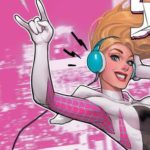
 In Spider-Gwen: Smash #1, Gwen Stacy faces her most perilous adventure yet: serving as the opening act for Dazzler on tour.
In Spider-Gwen: Smash #1, Gwen Stacy faces her most perilous adventure yet: serving as the opening act for Dazzler on tour.
As a character very commonly associated with the multiverse now, Earth-65’s Gwen Stacy has seen a lot of versions of herself over the past few years, so perhaps because of this it seems Marvel is implementing a “back-to-basics” approach with her latest tales. This year’s Shadow Clones storyline stayed local to Earth-65 (although it still managed to fit in some multiversal implications) and Smash seems to be following that trend. This one even seems low concept by comparison in that regard.
The setup is simple: back on Earth-65 after various multiversal shenanigans, Gwen finds herself listless and increasingly frustrated with her circumstances. She only really wants to hang around for her dad at this point; not even her musical endeavors are enough anymore. But when The Mary Janes are offered to open for Dazzler and the Uncut Gems on tour, she (apprehensively) joins up. But you didn’t think things would be that simple, did you? A conspiratorial plot soon unveils itself, and Gwen finds herself involved with it.
As someone who trailed off on reading Spider-Gwen comics —note that this isn’t called Ghost Spider, her actual alias, because everybody just calls her the other one anyway— I appreciate the scope being scaled back here, which allows writer Melissa Flores to focus on the narrative at hand — and more importantly, keep me from feeling locked out of the proceedings. (Although doing some wiki-diving led me to a few fun kernels of lore, such as Earth-65’s Sue Storm becoming the Doctor Doom of this world.) Spider-Gwen: Smash #1 appears to be a fun, not especially complicated Spider-Gwen adventure on the surface, and I would be interested to check back in once it’s over. Partially because Dazzler exists in the world now, and I’m a very basic gay male who loves Dazzler.
The art by Enid Balám is also worth pointing out, as it sort of harkens back to Robbi Rodriguez’s original run on the title that defined so much of its early aesthetic. It’s not overtly similar at all to his art style, and more takes after the scratchy sensibility befitting that of a punk rocker like Gwen. Exaggerated proportions and dynamic posing come into play her like they did under Rodriguez, so it helps Smash feel familiar and not derivative.




![[REVIEW] ‘THE MANDALORIAN CHAPTER 16: THE RESCUE’ IS STAR WARS AT ITS BEST](https://geekd-out.com/wp-content/uploads/2020/12/Mando16-150x150.jpg)